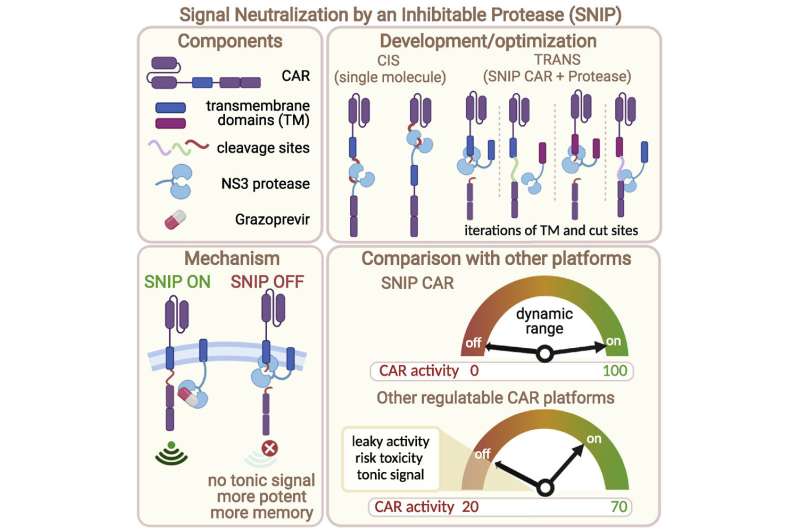
A cancer treatment that uses a patient’s own genetically modified immune cells to attack cancer cells is safer and more effective when it can be toggled on and off by an oral medication, according to a recently published Stanford Medicine study in mice.
The original therapy, known as CAR-T cell therapy, has been remarkably effective against some types of blood cancers. But, because some patients experience a life-threatening immune reaction to the engineered cells, CAR-T therapy is usually used only after other treatments have been tried.
It’s also been less successful in patients with solid tumors such as those in brain and bone cancers. Researchers believe this is because the CAR-T cells, which are prone to excessive signaling become exhausted before they can eliminate solid tumors. Additionally, unlike in blood cancers, it is difficult to identify molecular targets on solid tumors that are found only on the cancer cells and not on normal tissue.
The Stanford researchers devised a modified CAR-T cell therapy, termed SNIP CAR-T, that is activated with an oral medication for hepatitis that’s already approved for use in humans by the Food and Drug Administration. (Without the drug, the SNIP CAR-T cells are inactive.)
The ability to control the cells’ activity with medication after they’ve been infused back into the patient provides a safety mechanism for those who may respond poorly to the genetically modified cells. The researchers also found that the modified CAR-T cells were significantly more effective at tackling solid cancers in laboratory mice—possibly because the cells experienced brief, repeated periods of rest as the daily medication is metabolized in the animals’ bodies.
“We’ve created a ‘remote-controlled’ CAR-T therapy that is tunable for each patient,” said Crystal Mackall, MD, the Ernest and Amelia Gallo Family Professor and a professor of pediatrics and of medicine. “These modified CAR-T cells are not only safer but they are also. more potent and more versatile than the original CAR-T cells. It’s a pretty sophisticated system.”
Mackall is the senior author of the study, which was published online April 27 in Cell. Graduate student Louai Labanieh is the study’s lead author.
“I was surprised by the degree to which the SNIP CAR-T cells were better than conventional CAR-T therapy,” Labanieh said. “Where conventional CAR-T completely failed, SNIP CAR-T cells completely cured mice with solid tumors in the bone and nervous system.”
Because the oral medication that triggers the SNIP CAR-T cells’ activity is already approved by the FDA, the researchers hope to launch clinical trials in people with solid tumors within the next 24 months.
Putting immune cells to work
CAR-T cells are made from immune cells called T cells that are collected from a patient and genetically engineered in a laboratory to recognize and attack cancer cells with a specific molecule on their surfaces. They are then infused back into the patient to fight the disease. When the receptor on the CAR-T cells binds to the target on the cancer cell, it starts a chain reaction inside the CAR-T cell that signals it to kill the cancer cell.
CAR-T cell therapy was first approved by the FDA in 2017 for use in children and young adults with acute lymphoblastic leukemia. Since then, it’s also been approved for use in adults with other blood cancers, including multiple myeloma and several types of lymphoma. The original form of the therapy targets a molecule on the surface of the cancer cells called CD19, but researchers are also testing CAR-T cells that recognize other molecules or two molecular targets instead of one.
Labanieh wanted to develop a CAR-T system that could be easily controlled after the cells are returned to the patient. He introduced a viral protein in the CAR-T cells called a protease. This protease cuts the CAR-T receptor on the inner side of the cell membrane, blocking the signaling cascade that triggers the cells’ killing activity. The protease can be inactivated by a drug called grazoprevir that is approved to treat hepatitis C. In the absence of the drug, the cells are inactive; when the drug is present, the cells begin killing cancer cells.
Labanieh and his colleagues showed that SNIP CAR-T cells are inactive in laboratory mice in the absence of grazoprevir. Conversely, when the mice were given grazoprevir orally, the protease is inhibited and the SNIP CAR-T cells are activated. In a mouse model of CAR-T-induced lethal toxicity, mice that were treated with SNIP CAR-T cells recovered after grazoprevir treatment stopped—demonstrating the system’s potential to act as a safer alternative for patients than conventional CAR-T therapy.
“Previous efforts to create drug-regulatable CAR-T cells have yielded systems that are very finicky, or leaky,” Labanieh said. “This is the first time we’ve been able to tune their activity so precisely.”
“When the SNIP CAR-T system with full dose grazoprevir is on, it’s full on,” Mackall added. “And when the grazoprevir is gone, it’s off. This is critical for patients who experience toxicity. We could turn the cells off and give the patient time to recover. Most other safety switches are designed to kill the CAR-T cells, or to turn them off forever. The patient might survive the treatment, but still not be cured of their cancer.”
Targeting solid tumors
When the researchers tested the ability of the SNIP CAR-T cells to fight solid cancers in the mice, they found that they were much more effective than conventional CAR-T therapy—in many cases curing mice with a brain cancer called medulloblastoma or a bone cancer called osteosarcoma.
Unexpectedly, they also found that modulating the dose of grazoprevir made the CAR-T cells more discerning, focusing their killing activity on cancer cells with high levels of a target molecule while sparing normal tissue with lower levels of the same molecule. The ability to engineer CAR-T cells to recognize target molecules that also occur on healthy cells could transform the ability to tackle human solid tumors, the researchers said.
Source: Read Full Article
